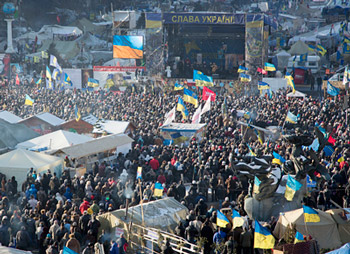

Vol. 78/No. 6 February 17, 2014

|
| AP Photo/Darko Bandic |
| Feb. 2 protest in Kiev demands resignation of pro-Moscow Ukraine officials. Russian President Vladimir Putin has frozen loan to Ukraine in bid to push for crackdown on opposition. |
The protests began in November when Yanukovich, in face of threats by Moscow, backed out of a deal for Ukraine to join a trade bloc with the European Union. The Russian government of President Vladimir Putin tried to help Yanukovich defuse the demonstrations by offering $15 billion in loans and lower prices on Russian gas.
Ukraine came under Russian control in the 17th century. In the 1917 Russian Revolution, the Bolsheviks led by V.I. Lenin led the workers and farmers to power. They backed the right of self-determination of peoples subjugated by the czarist empire.
After Lenin’s death, this revolutionary course was reversed when a growing privileged layer centered in the state bureaucracy led by Josef Stalin carried out a bloody counterrevolution, including trampling on the national rights of the people of Ukraine. They brought back with a vengeance the policies of subjugation and Russification begun by the czars.
Putin maintains Russian boot
After the collapse of the Soviet Union in 1991, Ukraine declared its formal independence, but still remained a political and economic vassal of Russia. While Ukrainian is the principal language for two-thirds of the country, Russian predominates in large parts of the eastern and southern parts, which are also the more industrially developed regions.Former Soviet bureaucrats used their positions to assemble fortunes for themselves and their cronies as chunks of the Russian economy were privatized. Former KGB political police lieutenant-colonel Putin took the presidency on behalf of these new capitalist layers. His regime is the true heir of the Stalinist police apparatus and murder machine.
Moscow still has close ties to Ukraine’s police apparatus and the armies of both countries have held joint exercises since Yanukovich took office.
Yanukovich attempted to quell the demonstrations with police violence and pushed through a law restricting the right to protest. The move backfired. The protests widened, including to the southern and eastern parts of the country, which have been Yanukovich’s main base of support.
As the protests spread, Yanukovich offered concessions, while his police forces continued to selectively go after leading activists in the opposition. His prime minister and cabinet resigned Jan. 28, and Yanukovich invited opposition leaders to join the government. He signed a repeal of the anti-protest law Jan. 31 and approved an amnesty for jailed protesters, on condition they evacuate government buildings they have occupied in Kiev and other cities.
The main opposition parties rejected the concessions. They demanded the immediate release of more than 100 people arrested in recent weeks. At least six people have been killed by cops and pro-government thugs and many others kidnapped and beaten since the protests began.
The protests in Ukraine have begun to win support from other opponents of Putin’s autocratic rule, including in Russia itself. At a Feb. 1 protest of several thousand in Moscow calling for freeing 20 people arrested at an anti-Putin demonstration in May 2012, some participants carried Ukrainian flags in solidarity with the protests there.
In addition to suffering under Russian tyranny, Ukraine has been especially hard hit by the worldwide capitalist economic crisis. Its economy contracted by nearly 15 percent in 2009, among the biggest declines in the world.
The Ukraine government owes $5.5 billion in loans due in 2014, $3 billion of it to the International Monetary Fund, but its foreign currency reserves have dropped by about one-third over the past year. Another $10 billion is due next year.
The IMF, prior to the latest crisis, has been urging Kiev to cut fuel subsidies and other government spending as a condition for more loans, steps that would fall heavily on working people.
President Putin has sought to take advantage of Ukraine’s precarious economic crisis to strengthen Moscow’s hand and to press Yanukovich to take a harder line on the protests.
Russian government freezes loans
While $3 billion of the promised loan was previously released, Putin put a hold on the rest Jan. 29. And Moscow has begun implementing stepped-up border checks on rail and truck traffic from Ukraine and demanded increased duties on food and machinery cargos. According to Time magazine, “Customs agents forced the Ukrainian trucks to stop, unload their cargo and wait in the freezing cold while the cargo was inspected piece by piece.”This is not the first time since the collapse of the Soviet Union that Moscow has tightened the screws to keep Ukraine in line. Numerous times Moscow has threatened to halt supplies of natural gas — and followed through — to press Ukraine to pay outstanding bills and kowtow to Moscow’s demands.
Related articles:
Crimean Tatars join anti-Putin actions in Ukraine
Front page (for this issue) |
Home |
Text-version home